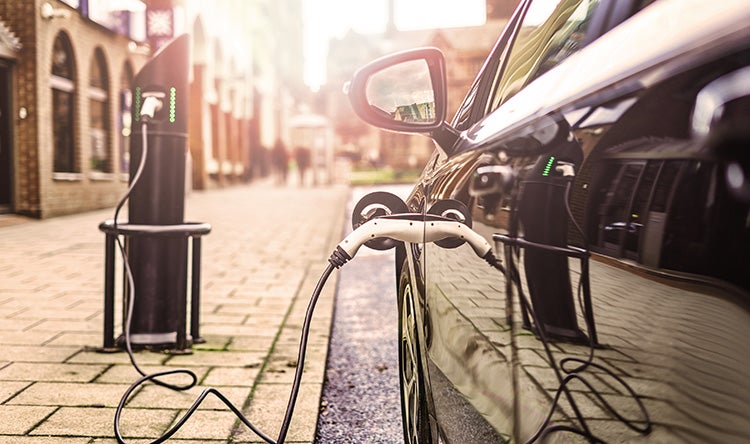
Experts Talk: Preparing Communities for Electric Vehicles with Rob Mowat
Experts Talk is an interview series with technical leaders from across our transportation program.
Developing a Comprehensive, Inclusive Plan to Tap the Potential of Zero Emissions Vehicles
The number of electric cars and trucks in our communities grows every day as prices fall and model options increase. Many cities are celebrating this transition, which will help them reach important emissions and air quality goals. But to fully realize the potential of electric vehicles, communities need careful planning to ensure equity across socioeconomic groups. Smartly managing this transition starts with a comprehensive community preparedness plan.
With more than 30 years of experience in the transportation industry, Rob Mowat leads HDR’s Zero Emissions Mobility Practice. His expertise in technology transitions has helped multiple communities plan for successful deployments of fleet electrification and modernization. In this interview, he discusses the need for community preparedness plans, how they are structured to include all residents of a community and explains why smart community leaders should begin working on this now.
Preparing Communities for Electric Vehicles
Q. What is a community preparedness plan and why is it important to have one?
A. A community preparedness plan is a blueprint that cities, towns or other municipalities can use to encourage and support the adoption of electric vehicles. The plan leads communities through all the steps they need to take to encourage citizens, businesses and government agencies to use electric vehicles, including policy changes, incentives, educational programs, public infrastructure needs and communication. This is important because as we have seen with all new technologies, their adoption rates vary.
A finished preparedness plan connects all the steps from A to Z and identifies important partners. It sets milestones and expectations so a community can measure progress, such as how many community partners should be involved and what infrastructure should be available by the time a particular adoption rate is achieved. It's a programmed approach to encourage the adoption and support of electric vehicles. By identifying all of the information and actions in the plan, cities can move forward strategically toward their community goals, rather than a much less effective piecemeal approach that leaves some residents behind or forgets important steps.

Q. How do preparedness plans consider a community’s unique characteristics and demographics?
A. Every community is different, so preparedness plans start with an analysis of existing conditions. This involves extensive community outreach, including electronic surveys, open houses, educational events, fair booths, even outreach to industry segments such as auto dealers or operators of airport shuttles. We also work with local partners such as business associations, employer centres and nonprofits to reach as many parts of a community as possible, gathering input from all groups that will be affected.
For example, in one area of town, the cost of a vehicle may not be a problem but residents don’t like the models that are available. Across town, perhaps they don’t mind the models, but vehicle range may be a high concern. There are 8-10 consistent reasons that people will cite for not buying an electric vehicle, but these often change in priority depending on the community, demographics and neighbourhood. It’s important to know what those different perceptions are across a community to effectively address them.
After getting a base reading of the community interest and support, we gauge expectations and needs among key stakeholders, such as the local utility and any fleet operators. Legislative requirements are reviewed, in particular any that mandate action by specific deadline associated with the adoption of electric or zero-emission vehicles. Then we take inventory of what already exists, looking at infrastructure already in place, how many public chargers are available, where they are and how many electric vehicles are already in use. We compare all that data to national and state averages and trends to forecast what a community should expect in the coming years.
Once we have a list of all the local barriers and the existing conditions, we build a plan to fill in the gaps. If a group is heavily influenced by charging infrastructure, a plan can include suggestions on where to add more. Educational programs are also common components, addressing misinformation or a lack of information.
In a nutshell: A plan is built by looking at current community conditions, forecasting what the future will look like, determining where the gaps are, then creating a customized strategy to bridge between where a community is and where it wants to go.
Q. How are underserved and disadvantaged populations accounted for in a community preparedness plan?
A. This is a common concern. electric cars and supporting infrastructure can be expensive, so cities work hard to make sure that all parts of the community can take advantage of community-developed infrastructure.
There are two main ways to address this:
- First, it’s important to look at options outside traditional vehicle ownership. Car sharing programs and community transit options can provide ways for residents to access electric vehicles as a rider or driver even if they can’t buy one on their own.
- Second, ensure any plan has clear sequencing, with immediate needs addressed but also containing a well-defined focus on future needs. That helps communities build equity and buy-in, by showing everybody in a community where they fall in the plan and making it clear that nobody is being ignored.
As cities begin to look at funding options for their plans, they should consider grants available specifically for more disadvantaged communities. These grants may help fund new infrastructure like public chargers in a high-density, multi-family area where individual garages are not available for overnight charging. Owners who live in a single-family home and have a garage or driveway to park in every night can find it relatively simple to charge their car overnight. However, those in multifamily housing such as an apartment, duplex or condominium will have a much more challenging time, with parking spaces that are often shared and landlords or homeowners' associations that are hesitant to give up space for dedicated charging. Initially, it may seem counterintuitive to put a charger where there is light demand, but having the infrastructure available can itself encourage adaption.
Currently, about 80% of individual cars are charged at home overnight. Experts expect that in the next 5-10 years, as electric vehicles reach cost parity with conventional vehicles and the secondary vehicle market further develops, 65% of cars will be charged at homes overnight, with 35% being charged somewhere else. To ensure those in multifamily housing can take advantage of these vehicles, new public infrastructure will be needed.

Q. What does a finished community preparedness plan include?
A. Each plan is different, depending on the community and what its leaders have asked for. But in general, a preparedness plan will include the following elements:
- Community baseline — An overview of current community adoption rates, perceptions of electric vehicles and barriers to increased adoption
- Equity review — A specific focus on what can be done to ensure that all of the community benefits from the transition to electric vehicles
- Policy recommendations — Suggestions for new policies to encourage adoption, such as parking policies, building ordinances, tax incentives, permitting changes and more
- Infrastructure recommendations — Public chargers needed, site-location best practices and guidelines, power/utility upgrades that may be needed
- Educational programs — Informational strategies for ensuring residents know how electric vehicles and charging work, what they need to know to overcome concerns about the technology, dispelling myths and misunderstandings
- Stakeholder coordination — Guide for what’s needed from partners, such as local utilities, educational system, large business districts, etc.
- Adoption forecast — Predictions for local adoption rates in the near- and mid-term
- Funding forecast — Estimates of how much funding will be needed and when, as well as identification of resources and grants available to fund the introduction of public electrification charging infrastructure
These recommendations are specific to each community and its local needs, regulations and demographics. For example, a policy recommendation for a community with high-occupancy vehicle lanes could be to offer access to drivers of electric vehicles. Or when determining where to locate public charging stations, a plan may recommend putting multiple stations at the parking spaces closest to a local four-way stop. That allows parking enforcement to go to one intersection to check compliance, rather than make multiple stops if chargers were placed mid-block.
Q. Why plan now instead of waiting to see how technology evolves and residents react?
A. Planning ahead offers a better opportunity for cities to orchestrate how they spend their local money and when they spend it so that they get the best return on their investment. Many grant programs also require plans or rank applicants higher if they have a plan and can show how funding will be used.
With preparation and a better idea of their needs, communities can start taking advantage of available state, federal and public utility grants. They can also start implementing plans and have new services ready when residents are ready. If cities wait until residents clamour for this public infrastructure and community readiness, they will hold back adoption because many of these updates take time.
For example, cities that start planning now can talk to their local utility and begin discussions about a special rate for electric vehicle charging. These rates can take years to be approved. Cities that have performed the proper coordination and have agreements in place when their infrastructure is built will see an easier transition. Those that haven’t started discussions with a utility could get an unwelcome surprise if, for instance, they install infrastructure and then find out it could take months or years longer for a utility to get the needed amount of power to the installed chargers.
Those who wait until the last minute will also find that it costs more. Projects that are hastily put together often include more missteps due to a lack of planning. Without planning ahead, projects also often need to be done immediately, requiring more local money because there is not time to wait for grants to be applied for and received. It’s much better for cities to take this transition on at their own pace, when they want to do it, how they want to do it, instead of making important decisions at the last minute.

Inspiration & Advice
Q. How did you become involved in electric vehicle planning?
A. The transportation industry has always kept an eye on emerging technology and cleaner propulsion solutions. As someone with an environmental passion and professional experience working with integrating and developing new technologies, a full-time electrification focus was a natural progression for me.
Q. What advice do you have for others starting their career in zero-emissions mobility?
A. If you like solving puzzles in a fast-paced environment where the final image routinely changes, then zero-emissions mobility is for you. Zero emissions mobility is an emerging technology that is expanding and advancing every day. The application of these discoveries for communities, fleets and infrastructure provide unlimited opportunities in research, planning, design, implementation and operations. I’d encourage anyone that enjoys new technology to get involved and find an environment where they can experience the research areas and fields of application so they can determine what ignites their imagination.
Each Experts Talk interview illuminates a different aspect of transportation infrastructure planning, design and delivery. Check back regularly to gain insights from specialized experts and thought leaders behind our award-winning, full service consulting practice.




